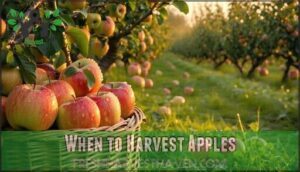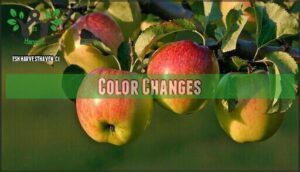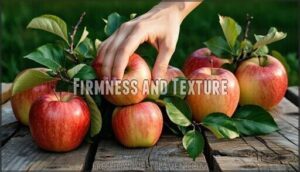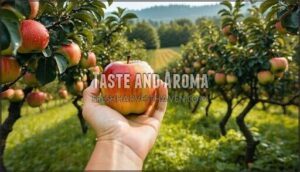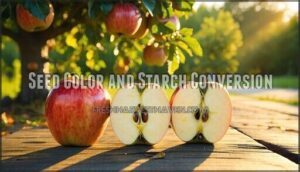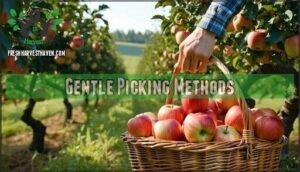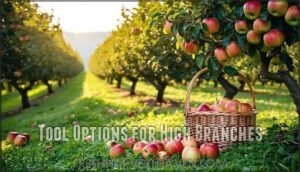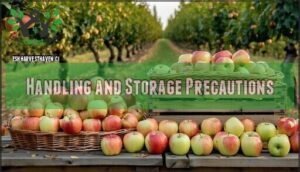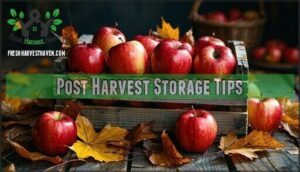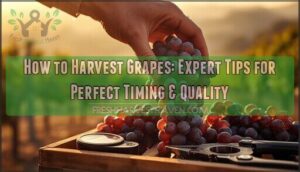This site is supported by our readers. We may earn a commission, at no cost to you, if you purchase through links.

Test ripeness by gently lifting the apple – it should separate easily from the branch with a slight twist.
The fruit’s background color shifts from green to cream or yellow, while seeds turn dark brown.
Ripe apples feel firm but yield slightly to pressure and smell fragrant near the stem.
Timing varies by variety: early apples ripen in summer, while late varieties wait until fall.
Don’t wait for all apples to ripen simultaneously – harvest occurs over several weeks.
The secret lies in reading these subtle clues together, using signs like ripe apples and the change in background color, to determine the best time for harvest, and understanding that timing varies.
Table Of Contents
- Key Takeaways
- Harvest Timing Factors
- When to Harvest Apples
- Apple Ripeness Indicators
- Harvesting Techniques Tips
- Post Harvest Storage Tips
- Frequently Asked Questions (FAQs)
- When are apples harvested?
- When to harvest apples from a garden tree?
- When is the best time of year to pick apples?
- When is the best time to grow homegrown apples?
- When should you prepare for your apple harvest?
- Can you harvest all apples in one day?
- What month is good for picking apples?
- Do apples ripen after they are picked from the tree?
- Why do apples fall off the tree before they are ready?
- How often should I water apple trees before harvest?
- Conclusion
Key Takeaways
- Test ripeness with the twist method – You’ll know your apples are ready when they separate easily from the branch with a gentle upward twist and slight rotation.
- Watch for color and texture changes – Look for the background color to shift from green to cream or yellow, while ripe apples should feel firm but yield slightly to pressure.
- Don’t wait for simultaneous ripening – You’ll need to harvest over several weeks since apples ripen at different rates, even on the same tree.
- Handle with care during picking – Use gentle lifting motions and padded containers to prevent bruising, then store at 30-32°F with high humidity for maximum shelf life.
Harvest Timing Factors
Knowing when to pick your apples isn’t just about watching the calendar—it’s about understanding how variety, weather, and your tree’s condition work together.
You’ll get the best harvest by considering these three key factors that determine whether your apples are truly ready to enjoy.
Apple Variety Impact
Your apple variety dramatically influences when you’ll harvest those crisp, juicy fruits.
Timing your harvest right turns good apples into great ones.
Different cultivars ripen weeks apart, making variety selection vital for timing your apple harvest perfectly.
Key variety timing differences:
- Summer apples like Gala harvest from mid-August to early September
- Early fall varieties including Red Delicious ripen mid to late September
- Late-season apples such as Granny Smith reach maturity in mid to late October
- Extended-season cultivars like Fuji need until November for peak ripeness
- Ultra-early types like Lodi are ready as early as July-August
Understanding your specific apple varieties helps you plan multiple harvests and guarantees each type reaches peak apple maturity before picking. Consider how climate suitability matters for ideal growth.
Climate and Weather Effects
Weather directly impacts your apple harvest timing more than you might expect.
Mother Nature sets the schedule, not your calendar.
Temperature swings, rainfall patterns, and sunlight exposure can shift your picking schedule by weeks.
| Weather Factor | Early Impact | Late Impact |
|---|---|---|
| Temperature | Hot summers advance ripening 7-14 days | Cool falls delay harvest 2 weeks |
| Rainfall | Spring rain delays blossoms | Pre-harvest rain causes splitting |
| Sunlight | Full sun improves sugar content | Cloudy weather slows starch conversion |
| Frost | Late spring frost pushes back harvest | Early fall frost can damage fruit |
Regional variations matter too – northern orchards harvest later, while warmer climates accelerate ripening but may reduce storage quality.
Tree Health Influence
Your apple tree’s overall health directly affects when fruit reaches peak ripeness.
Trees struggling with disease impact or pest damage often produce apples that ripen unevenly or never reach their full potential, making harvest timing tricky.
- Disease Impact: Fungal infections like apple scab delay proper fruit development
- Nutrient Deficiencies: Poor apple fertilization leads to smaller, slower-ripening fruit
- Sunlight Exposure: Proper apple pruning guarantees adequate light penetration for even ripening
- Pest Damage: Codling moth and other apple pests can cause premature fruit drop
When to Harvest Apples
Getting your timing right makes all the difference between crisp, flavorful apples and disappointing fruit.
September typically offers the sweet spot for apple harvest time, though this varies considerably by variety and location.
Early varieties like Gala reach apple maturity from mid-August through early September, while late-season types like Granny Smith won’t hit their prime timing until mid-October.
Your picking season window depends on recognizing when each variety reaches its ripening stages—neither too early when they’re still starchy, nor too late when they’ve lost their crunch and developed that soft, mealy texture nobody wants.
Similarly, when harvesting other fruits, it’s worth mentioning that color indicates ripeness.
Apple Ripeness Indicators
You’ll know your apples are ready to harvest when they show several key ripeness indicators that go beyond just color.
These visual, tactile, and sensory cues work together to tell you when your fruit has reached peak quality and flavor.
Color Changes
Watching color changes gives you reliable clues about apple ripeness.
The ground color—that baseline hue beneath any red blush—shifts from green to yellowish-green or golden as apples mature.
Green undertones gradually fade while varietal color deepens.
Red varieties develop their characteristic red blush, though don’t rely solely on this since some apples turn red before they’re actually ripe.
The surface wax also becomes less pronounced, giving ripe apples a slightly duller appearance compared to their waxy, immature shine.
This change, combined with the shift in ground color, provides a more accurate indication of apple ripeness and maturity, helping you choose the best apples.
Firmness and Texture
Beyond color, apple firmness tells the real story of ripeness.
Ripe apples feel firm but not rock-hard when you squeeze gently.
They’ll have crisp texture that yields slightly under pressure.
Overripe apples start softening and lose their characteristic crispness levels.
Each variety shows different bruising susceptibility, so handle with care.
Proper firmness guarantees better storage impact and maintains quality longer.
Taste and Aroma
Once you’ve checked apple firmness, let your senses be your guide.
Bite into a sample—ripe apples are crisp, juicy, and the apple flavor should pop.
You’ll notice Sweetness Levels and Tartness Balance shift as Flavor Development peaks.
Varietal Aromas and Aromatic Compounds intensify, giving off that classic apple scent.
Trust your nose and taste buds—they rarely steer you wrong.
Seed Color and Starch Conversion
For veteran apple growers, seed browning stages reveal vital apple maturity signs beyond surface appearances.
When you cut open an apple, mature seeds display deep brown or black coloration, indicating ideal starch-sugar ratio conversion.
The iodine dip test confirms this internal transformation—ripe apples show minimal blue-black staining as starch converts to sugar.
Aroma intensity increases as apples approach peak ripeness, complementing visual cues.
Conversion rate factors like temperature and variety affect ripeness correlation timing, making these dual indicators essential for perfect harvest decisions.
Harvesting Techniques Tips
Once you’ve determined your apples are ripe, you’ll need the right technique to harvest them without damaging the fruit or tree.
The key is using gentle methods that preserve both your apple’s quality and your tree’s health for next year’s crop.
Gentle Picking Methods
Proper apple harvesting techniques prevent damage and guarantee quality fruit. Start with an upward twist motion, gently lifting each apple while rotating it slightly to encourage natural stem detachment.
This method protects the tree’s delicate spur wood from breaking. Always avoid pulling straight down or yanking, which can damage branches and reduce future yields.
When using ladder safety becomes important for higher branches, maintain three points of contact and never overreach. Focus on avoiding bruising by placing each apple gently into your container rather than dropping them, to ensure the best possible outcome with proper apple harvesting techniques and maintain the tree’s health for future yields.
Tool Options for High Branches
Reaching those high branches doesn’t require acrobatic skills when you’ve got the right apple harvesting equipment.
Modern telescoping pickers and fruit harvesters extend your reach safely from ground level, eliminating risky ladder climbing while protecting both you and your precious fruit.
A popular option is a telescoping fruit picker.
- Telescoping Pickers – Adjustable pole extenders with basket attachments reach 8-15 feet
- Fruit Harvesters – Specialized apple fruit picker tools with gentle gripping mechanisms
- Ladder Alternatives – Stable tripod pickers and branch spreaders for safer access
- Apple Harvesting Bags – Hands-free collection systems that attach to picker poles
Handling and Storage Precautions
Gentle apple handling during harvest makes all the difference between crisp autumn treats and mushy disappointments.
Use padded containers for bruise prevention and handle each apple like a delicate egg.
To guarantee safe transport, consider using specialized apple storage.
Sort immediately after picking for rot minimization, separating damaged fruit from perfect specimens.
Store varieties separately since different types have unique ventilation needs and moisture retention requirements, preventing cross-contamination and apple spoilage to ensure the best harvest results.
Post Harvest Storage Tips
Once you’ve picked your apples, you’ll want to store them properly so they stay crisp and tasty as long as possible.
It’s not rocket science, but a few smart steps can help you avoid a fridge full of mushy surprises.
Temperature and Humidity Control
Once you’ve picked your apples properly, maintaining proper storage conditions becomes your next priority.
Your freshly harvested fruit needs specific environmental controls to maximize shelf life and quality.
Proper apple storage requires three key elements:
- Suitable Temperatures: Keep apples at 30-32°F (-1 to 0°C) for maximum longevity
- Humidity Levels: Maintain 90-95% relative humidity to prevent moisture loss
- Storage Ventilation: Guarantee adequate airflow while avoiding condensation buildup
These controlled atmosphere conditions slow respiration and prevent premature aging, extending your apple storage from weeks to months.
Ethylene Gas Management
Understanding ethylene gas helps you prevent your apples from ripening too quickly after harvest.
This natural plant hormone accelerates fruit ripening and can reduce storage life by up to 30% when levels get too high in your storage area.
| Ethylene Source | Production Rate | Storage Impact |
|---|---|---|
| Fresh apples | 0.1-10 µL/kg·h | Normal ripening |
| Damaged apples | 3x higher rates | Rapid spoilage |
| Mixed storage | Variable levels | Uneven quality |
Control ethylene by removing bruised fruit immediately, ensuring proper storage ventilation, and keeping apples separate from other produce that’s sensitive to this ripening gas.
This approach helps in maintaining the quality and extending the storage life of the apples, which is crucial for a successful harvest.
Sorting and Packaging Methods
Proper apple sorting and packaging methods protect your harvest and extend storage life.
Start with size separation—larger apples ripen faster and should be used first.
Conduct thorough damage assessment, removing bruised or punctured fruit immediately.
For container selection, choose breathable baskets lined with perforated plastic for moisture retention.
This apple packaging approach prevents quality loss while maintaining ethylene control.
Consider apple grading machinery to improve efficiency.
Sort varieties separately since different types have varying storage needs.
Handle each apple gently during fruit handling to preserve your apple preservation methods investment.
Preservation Options for Excess Apples
When you’ve got more apples than you can eat fresh, several preservation methods keep your harvest useful year-round.
Apple drying creates portable snacks that last twelve months in sealed containers. Freezing apples works best for baking – blanch slices first to maintain texture.
For long-term storage, vacuum sealing fruit prevents freezer burn.
Canning apples into sauces or pie fillings provides shelf-stable options for eighteen months. Consider donating excess apples to local food banks too, as a way to share your fresh harvest and support your local community, and help those in need with nutritious food.
Frequently Asked Questions (FAQs)
When are apples harvested?
Like ripening fruit on nature’s calendar, you’ll harvest apples from July through November, depending on variety.
Early types like Gala ripen mid-August, while late varieties like Granny Smith wait until October for peak sweetness.
When to harvest apples from a garden tree?
You’ll know your apples are ready when they twist off easily with a gentle upward motion.
They should taste sweet rather than tart,
and show their variety’s characteristic color with firm, crisp flesh.
When is the best time of year to pick apples?
Wondering when your apple tree’s ready to share its bounty?
Most apple varieties reach peak ripeness between late August and early October, with September being the prime picking month for most homegrown apples.
When is the best time to grow homegrown apples?
You’ll want to plant apple trees in early spring after the last frost, typically March through May. Choose a sunny spot with well-draining soil and space trees properly for airflow.
When should you prepare for your apple harvest?
You should prepare for apple harvest about 2-3 weeks before your expected harvest date.
Start gathering baskets, checking storage areas, and monitoring ripeness indicators like background color changes and the easy-twist test.
Can you harvest all apples in one day?
You can’t harvest all apples in one day because they ripen at different rates. Conduct multiple harvests spaced about a week apart for uniform ripeness and quality.
What month is good for picking apples?
September’s golden embrace signals nature’s perfect timing for apple picking.
You’ll find most varieties reach peak ripeness between late August and early October, with September being the sweet spot for harvesting crisp, flavorful apples.
Do apples ripen after they are picked from the tree?
Apples don’t ripen much after you’ve picked them from the tree.
They’ll continue converting starches to sugars for a short time, but they won’t develop further sweetness, color, or texture improvements like tree-ripened fruit.
They will have a different quality compared to tree-ripened fruit, in terms of color and texture.
Why do apples fall off the tree before they are ready?
Immature apples drop due to natural fruit thinning, stress from drought or disease, pest damage, or poor pollination.
You’ll also see windfalls from storms that knock down perfectly good fruit before it’s ripe, which can be considered a form of natural occurrence.
How often should I water apple trees before harvest?
You’ll want to water your apple trees deeply once or twice weekly before harvest, providing about one inch of water total. Adjust frequency based on rainfall and soil moisture levels.
Conclusion
Remarkably, homegrown apple trees can produce fruit for over 100 years when properly maintained.
Mastering when to harvest homegrown apples transforms your gardening experience from guesswork to science. You’ve learned to read color changes, test firmness, and recognize aromatic signals that indicate peak ripeness.
Remember that different varieties ripen at their own pace, so don’t rush the process.
With proper timing and gentle harvesting techniques, you’ll enjoy crisp, flavorful apples that reward your patience and attention to detail.

